wiper blades Alfa Romeo Giulietta 2014 Owner's Manual
[x] Cancel search | Manufacturer: ALFA ROMEO, Model Year: 2014, Model line: Giulietta, Model: Alfa Romeo Giulietta 2014Pages: 280, PDF Size: 6.65 MB
Page 44 of 280
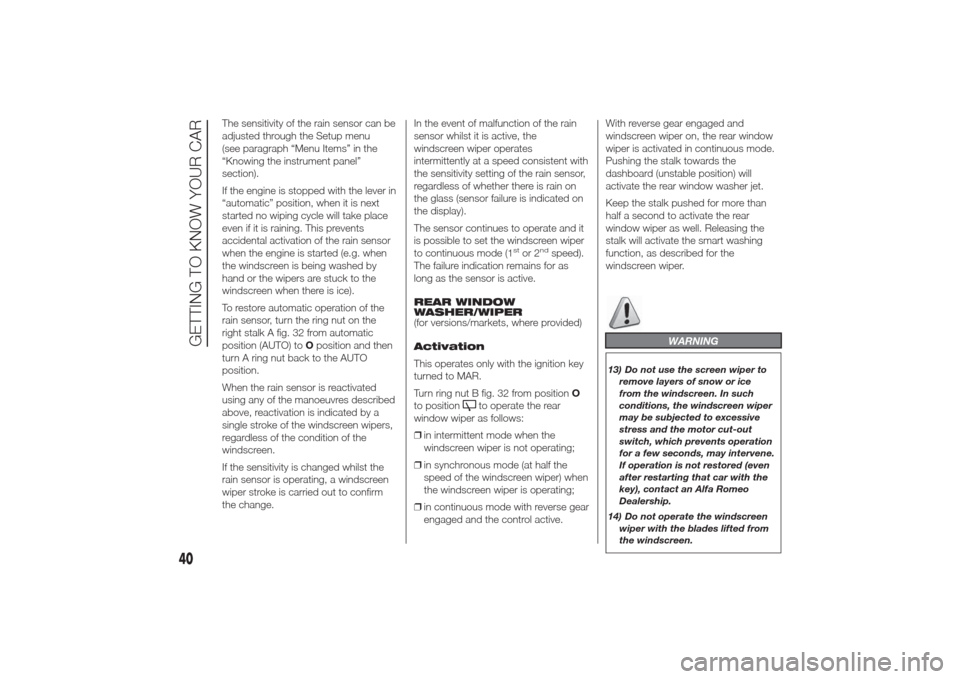
The sensitivity of the rain sensor can be
adjusted through the Setup menu
(see paragraph “Menu Items” in the
“Knowing the instrument panel”
section).
If the engine is stopped with the lever in
“automatic” position, when it is next
started no wiping cycle will take place
even if it is raining. This prevents
accidental activation of the rain sensor
when the engine is started (e.g. when
the windscreen is being washed by
hand or the wipers are stuck to the
windscreen when there is ice).
To restore automatic operation of the
rain sensor, turn the ring nut on the
right stalk A fig. 32 from automatic
position (AUTO) toOposition and then
turn A ring nut back to the AUTO
position.
When the rain sensor is reactivated
using any of the manoeuvres described
above, reactivation is indicated by a
single stroke of the windscreen wipers,
regardless of the condition of the
windscreen.
If the sensitivity is changed whilst the
rain sensor is operating, a windscreen
wiper stroke is carried out to confirm
the change.In the event of malfunction of the rain
sensor whilst it is active, the
windscreen wiper operates
intermittently at a speed consistent with
the sensitivity setting of the rain sensor,
regardless of whether there is rain on
the glass (sensor failure is indicated on
the display).
The sensor continues to operate and it
is possible to set the windscreen wiper
to continuous mode (1
stor 2
nd
speed).
The failure indication remains for as
long as the sensor is active.
REAR WINDOW
WASHER/WIPER
(for versions/markets, where provided)
Activation
This operates only with the ignition key
turned to MAR.
Turn ring nut B fig. 32 from positionO
to position
to operate the rear
window wiper as follows:
❒in intermittent mode when the
windscreen wiper is not operating;
❒in synchronous mode (at half the
speed of the windscreen wiper) when
the windscreen wiper is operating;
❒in continuous mode with reverse gear
engaged and the control active.With reverse gear engaged and
windscreen wiper on, the rear window
wiper is activated in continuous mode.
Pushing the stalk towards the
dashboard (unstable position) will
activate the rear window washer jet.
Keep the stalk pushed for more than
half a second to activate the rear
window wiper as well. Releasing the
stalk will activate the smart washing
function, as described for the
windscreen wiper.
WARNING
13) Do not use the screen wiper to
remove layers of snow or ice
from the windscreen. In such
conditions, the windscreen wiper
may be subjected to excessive
stress and the motor cut-out
switch, which prevents operation
for a few seconds, may intervene.
If operation is not restored (even
after restarting that car with the
key), contact an Alfa Romeo
Dealership.
14) Do not operate the windscreen
wiper with the blades lifted from
the windscreen.
40
GETTING TO KNOW YOUR CAR
Page 172 of 280
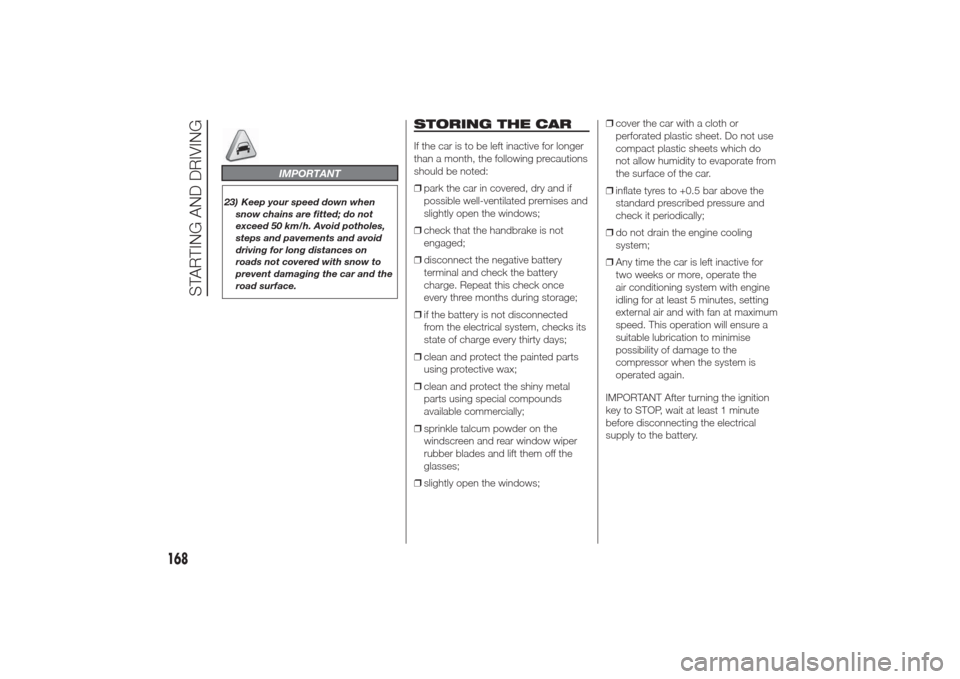
IMPORTANT
23) Keep your speed down when
snow chains are fitted; do not
exceed 50 km/h. Avoid potholes,
steps and pavements and avoid
driving for long distances on
roads not covered with snow to
prevent damaging the car and the
road surface.
STORING THE CARIf the car is to be left inactive for longer
than a month, the following precautions
should be noted:
❒park the car in covered, dry and if
possible well-ventilated premises and
slightly open the windows;
❒check that the handbrake is not
engaged;
❒disconnect the negative battery
terminal and check the battery
charge. Repeat this check once
every three months during storage;
❒if the battery is not disconnected
from the electrical system, checks its
state of charge every thirty days;
❒clean and protect the painted parts
using protective wax;
❒clean and protect the shiny metal
parts using special compounds
available commercially;
❒sprinkle talcum powder on the
windscreen and rear window wiper
rubber blades and lift them off the
glasses;
❒slightly open the windows;❒cover the car with a cloth or
perforated plastic sheet. Do not use
compact plastic sheets which do
not allow humidity to evaporate from
the surface of the car.
❒inflate tyres to +0.5 bar above the
standard prescribed pressure and
check it periodically;
❒do not drain the engine cooling
system;
❒Any time the car is left inactive for
two weeks or more, operate the
air conditioning system with engine
idling for at least 5 minutes, setting
external air and with fan at maximum
speed. This operation will ensure a
suitable lubrication to minimise
possibility of damage to the
compressor when the system is
operated again.
IMPORTANT After turning the ignition
key to STOP, wait at least 1 minute
before disconnecting the electrical
supply to the battery.
168
STARTING AND DRIVING
Page 205 of 280

SCHEDULED SERVICING PLAN1.4 Turbo Petrol and 1.4 Turbo MultiAir VERSIONSThousands of miles 18 36 54 72 90 108
Thousands of kilometres 30 60 90 120 150 180
Months24 48 72 96 120 144Check tyre conditions/wear and adjust pressure, if required●●●●●●
Check operation of lighting system (headlamps, direction indicators, hazard warning
lights, passenger compartment, luggage compartment, instrument panel warning
lights, etc.)●●●●●●
Check operation of windscreen washer/wiper system●●●●●●
Check the position/wear of the windscreen/rear window wiper blades●●●●●●
Check condition and wear of front disc brake pads and operation of pad wear
indicator●●●●●●
Check rear disc brake pad condition and wear●●●●●●
Condition and status visual check: bodywork exterior, underbody protection, pipes
and hoses (exhaust - fuel system - brakes), rubber elements (boots - sleeves -
bushes etc.)●●●●●●
Check cleanliness of bonnet and boot locks, as well as cleanliness and lubrication of
linkages●●●●●●
Check and, if necessary, top up fluid levels (engine cooling, hydraulic brakes/clutch,
screen washer, battery, etc.)●●●●●●
Check handbrake lever travel and adjust, if required●●●●●●
Check timing belt condition●●
201
Page 207 of 280
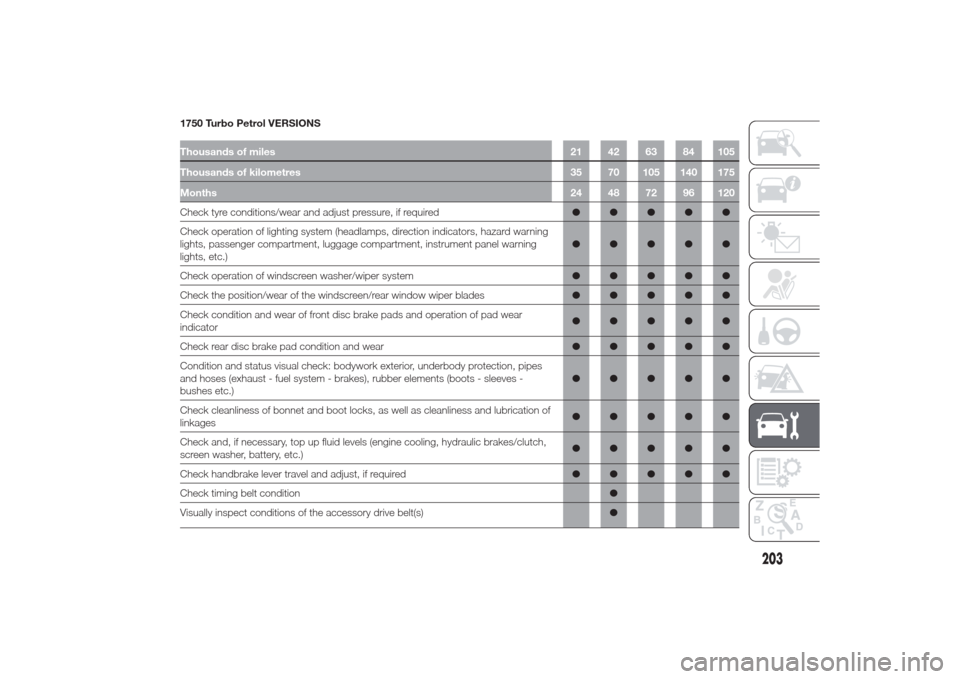
1750 Turbo Petrol VERSIONSThousands of miles 21 42 63 84 105
Thousands of kilometres 35 70 105 140 175
Months24 48 72 96 120Check tyre conditions/wear and adjust pressure, if required●●●●●
Check operation of lighting system (headlamps, direction indicators, hazard warning
lights, passenger compartment, luggage compartment, instrument panel warning
lights, etc.)●●●●●
Check operation of windscreen washer/wiper system●●●●●
Check the position/wear of the windscreen/rear window wiper blades●●●●●
Check condition and wear of front disc brake pads and operation of pad wear
indicator●●●●●
Check rear disc brake pad condition and wear●●●●●
Condition and status visual check: bodywork exterior, underbody protection, pipes
and hoses (exhaust - fuel system - brakes), rubber elements (boots - sleeves -
bushes etc.)●●●●●
Check cleanliness of bonnet and boot locks, as well as cleanliness and lubrication of
linkages●●●●●
Check and, if necessary, top up fluid levels (engine cooling, hydraulic brakes/clutch,
screen washer, battery, etc.)●●●●●
Check handbrake lever travel and adjust, if required●●●●●
Check timing belt condition●
Visually inspect conditions of the accessory drive belt(s)●
203
Page 209 of 280
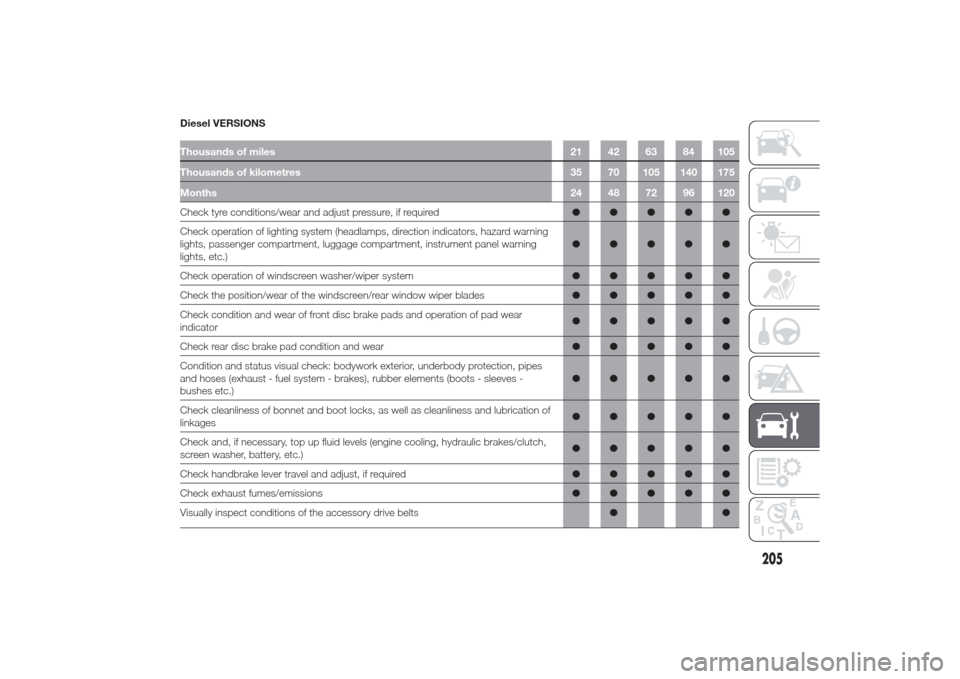
Diesel VERSIONSThousands of miles 21 42 63 84 105
Thousands of kilometres 35 70 105 140 175
Months24 48 72 96 120Check tyre conditions/wear and adjust pressure, if required●●●●●
Check operation of lighting system (headlamps, direction indicators, hazard warning
lights, passenger compartment, luggage compartment, instrument panel warning
lights, etc.)●●●●●
Check operation of windscreen washer/wiper system●●●●●
Check the position/wear of the windscreen/rear window wiper blades●●●●●
Check condition and wear of front disc brake pads and operation of pad wear
indicator●●●●●
Check rear disc brake pad condition and wear●●●●●
Condition and status visual check: bodywork exterior, underbody protection, pipes
and hoses (exhaust - fuel system - brakes), rubber elements (boots - sleeves -
bushes etc.)●●●●●
Check cleanliness of bonnet and boot locks, as well as cleanliness and lubrication of
linkages●●●●●
Check and, if necessary, top up fluid levels (engine cooling, hydraulic brakes/clutch,
screen washer, battery, etc.)●●●●●
Check handbrake lever travel and adjust, if required●●●●●
Check exhaust fumes/emissions●●●●●
Visually inspect conditions of the accessory drive belts●●
205
Page 211 of 280

PERIODIC CHECKSEvery 1,000 km or before long
journeys, check and, if necessary, top
up the following:
❒engine coolant, brake fluid and
windscreen washer fluid level;
❒tyre inflation pressure and condition;
❒operation of lighting system
(headlamps, direction indicators,
hazard warning lights, etc.);
❒operation of window washer/wiper
system and positioning/wear of
windscreen/rear window wiper
blades
Check and top up, if required, the
engine oil level every 3,000 km.
HEAVY-DUTY USE OF
THE CARIf the car is used mainly under one of
the following conditions:
❒towing a trailer or caravan;
❒dusty roads;
❒short, repeated journeys (less than
7-8 km) at sub-zero outside
temperatures;
❒engine often idling or driving long
distances at low speeds or long
periods of idleness;
the following checks must be carried
out more often than indicated in the
Scheduled Servicing Plan:
❒check front disc brake pad
conditions and wear;
❒check cleanliness of bonnet and boot
locks, cleanliness and lubrication of
linkage;
❒visually inspect conditions of: engine,
gearbox, transmission, pipes and
hoses (exhaust - fuel system -
brakes) and rubber elements (boots -
sleeves - bushes - etc.);
❒check battery charge and battery
fluid level (electrolyte);
❒visually inspect condition of the
accessory drive belts;❒check and, if necessary, change
engine oil and replace oil filter;
❒check and, if necessary, replace
pollen filter;
❒check and, if necessary, replace air
cleaner.
207
Page 220 of 280
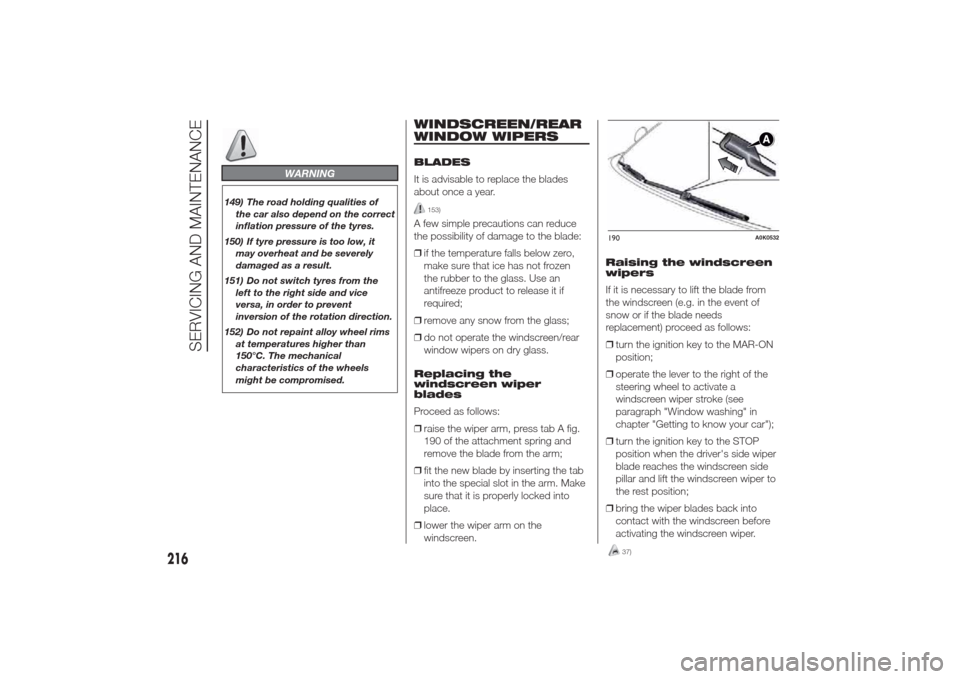
WARNING
149) The road holding qualities of
the car also depend on the correct
inflation pressure of the tyres.
150) If tyre pressure is too low, it
may overheat and be severely
damaged as a result.
151) Do not switch tyres from the
left to the right side and vice
versa, in order to prevent
inversion of the rotation direction.
152) Do not repaint alloy wheel rims
at temperatures higher than
150°C. The mechanical
characteristics of the wheels
might be compromised.
WINDSCREEN/REAR
WINDOW WIPERSBLADES
It is advisable to replace the blades
about once a year.
153)
A few simple precautions can reduce
the possibility of damage to the blade:
❒if the temperature falls below zero,
make sure that ice has not frozen
the rubber to the glass. Use an
antifreeze product to release it if
required;
❒remove any snow from the glass;
❒do not operate the windscreen/rear
window wipers on dry glass.
Replacing the
windscreen wiper
blades
Proceed as follows:
❒raise the wiper arm, press tab A fig.
190 of the attachment spring and
remove the blade from the arm;
❒fit the new blade by inserting the tab
into the special slot in the arm. Make
sure that it is properly locked into
place.
❒lower the wiper arm on the
windscreen.Raising the windscreen
wipers
If it is necessary to lift the blade from
the windscreen (e.g. in the event of
snow or if the blade needs
replacement) proceed as follows:
❒turn the ignition key to the MAR-ON
position;
❒operate the lever to the right of the
steering wheel to activate a
windscreen wiper stroke (see
paragraph "Window washing" in
chapter "Getting to know your car");
❒turn the ignition key to the STOP
position when the driver's side wiper
blade reaches the windscreen side
pillar and lift the windscreen wiper to
the rest position;
❒bring the wiper blades back into
contact with the windscreen before
activating the windscreen wiper.
190
A0K0532
216
SERVICING AND MAINTENANCE
37)
Page 221 of 280

Replacing the rear
window wiper blade
Proceed as follows:
❒raise cover A fig. 191, undo nut B
and remove arm C;
❒correctly position the new arm, fully
tighten the nut B then lower the
cover A.
NOZZLES
Windscreen washer
The windscreen washer nozzles are
fixed fig. 192.
If there is no jet of fluid, firstly check
that there is some fluid in the reservoir
(see paragraph "Checking fluid levels"
in this chapter).Then check that the nozzle holes are
not clogged, if necessary use a needle.
Rear window washer
The nozzle holder is located on the rear
window fig. 193.
The rear window washer jets are fixed.HEADLIGHT WASHERS
(for versions/markets, where provided)
These are located within the front
bumper fig. 194.
They are activated when the dipped
beam and/or main beam headlights are
on and the windscreen washer is
activated.
Check the correct condition and
cleanliness of nozzles at regular
intervals.
WARNING
153) Driving with worn windscreen/
rear window wiper blades is a
serious hazard, because visibility
is reduced in bad weather.
191
A0K0533
192
A0K0139
193
A0K0102
194
A0K0534
217
Page 222 of 280
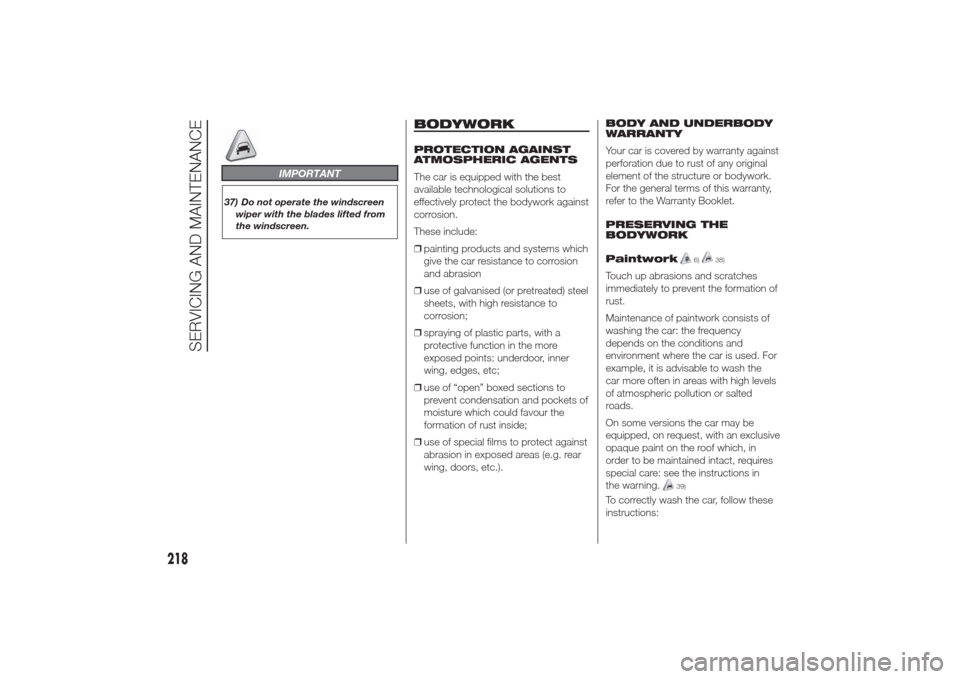
IMPORTANT
37) Do not operate the windscreen
wiper with the blades lifted from
the windscreen.
BODYWORKPROTECTION AGAINST
ATMOSPHERIC AGENTS
The car is equipped with the best
available technological solutions to
effectively protect the bodywork against
corrosion.
These include:
❒painting products and systems which
give the car resistance to corrosion
and abrasion
❒use of galvanised (or pretreated) steel
sheets, with high resistance to
corrosion;
❒spraying of plastic parts, with a
protective function in the more
exposed points: underdoor, inner
wing, edges, etc;
❒use of “open” boxed sections to
prevent condensation and pockets of
moisture which could favour the
formation of rust inside;
❒use of special films to protect against
abrasion in exposed areas (e.g. rear
wing, doors, etc.).BODY AND UNDERBODY
WARRANTY
Your car is covered by warranty against
perforation due to rust of any original
element of the structure or bodywork.
For the general terms of this warranty,
refer to the Warranty Booklet.
PRESERVING THE
BODYWORK
Paintwork
6)
38)
Touch up abrasions and scratches
immediately to prevent the formation of
rust.
Maintenance of paintwork consists of
washing the car: the frequency
depends on the conditions and
environment where the car is used. For
example, it is advisable to wash the
car more often in areas with high levels
of atmospheric pollution or salted
roads.
On some versions the car may be
equipped, on request, with an exclusive
opaque paint on the roof which, in
order to be maintained intact, requires
special care: see the instructions in
the warning.
39)
To correctly wash the car, follow these
instructions:
218
SERVICING AND MAINTENANCE
Page 277 of 280
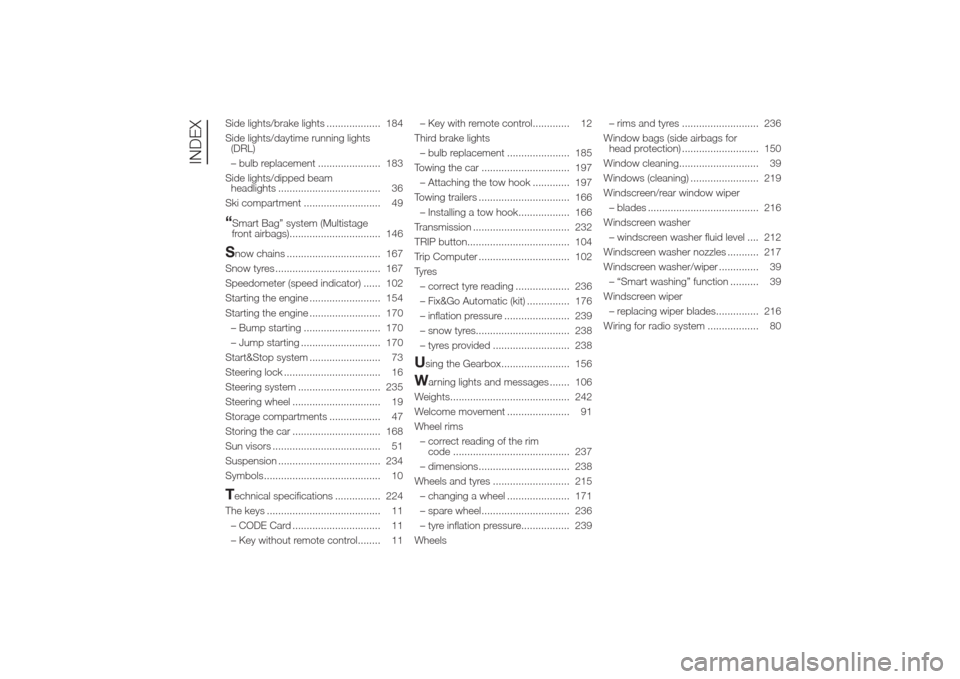
Side lights/brake lights ................... 184
Side lights/daytime running lights
(DRL)
– bulb replacement ...................... 183
Side lights/dipped beam
headlights .................................... 36
Ski compartment ........................... 49“Smart Bag” system (Multistage
front airbags)................................ 146Snow chains ................................. 167
Snow tyres ..................................... 167
Speedometer (speed indicator) ...... 102
Starting the engine ......................... 154
Starting the engine ......................... 170
– Bump starting ........................... 170
– Jump starting ............................ 170
Start&Stop system ......................... 73
Steering lock .................................. 16
Steering system ............................. 235
Steering wheel ............................... 19
Storage compartments .................. 47
Storing the car ............................... 168
Sun visors ...................................... 51
Suspension .................................... 234
Symbols......................................... 10Technical specifications ................ 224
The keys ........................................ 11
– CODE Card ............................... 11
– Key without remote control........ 11– Key with remote control............. 12
Third brake lights
– bulb replacement ...................... 185
Towing the car ............................... 197
– Attaching the tow hook ............. 197
Towing trailers ................................ 166
– Installing a tow hook.................. 166
Transmission .................................. 232
TRIP button.................................... 104
Trip Computer ................................ 102
Ty r e s
– correct tyre reading ................... 236
– Fix&Go Automatic (kit) ............... 176
– inflation pressure ....................... 239
– snow tyres................................. 238
– tyres provided ........................... 238
Using the Gearbox........................ 156W
arning lights and messages ....... 106
Weights.......................................... 242
Welcome movement ...................... 91
Wheel rims
– correct reading of the rim
code ......................................... 237
– dimensions................................ 238
Wheels and tyres ........................... 215
– changing a wheel ...................... 171
– spare wheel............................... 236
– tyre inflation pressure................. 239
Wheels– rims and tyres ........................... 236
Window bags (side airbags for
head protection) ........................... 150
Window cleaning............................ 39
Windows (cleaning) ........................ 219
Windscreen/rear window wiper
– blades ....................................... 216
Windscreen washer
– windscreen washer fluid level .... 212
Windscreen washer nozzles ........... 217
Windscreen washer/wiper .............. 39
– “Smart washing” function .......... 39
Windscreen wiper
– replacing wiper blades............... 216
Wiring for radio system .................. 80
INDEX